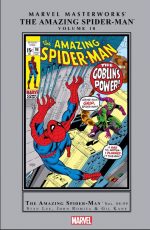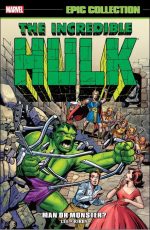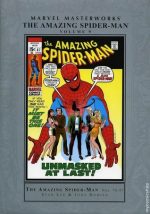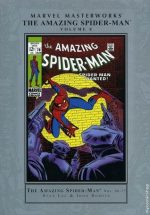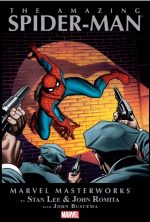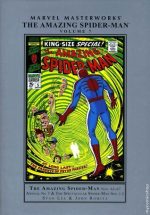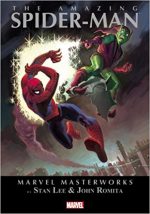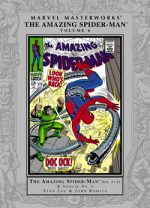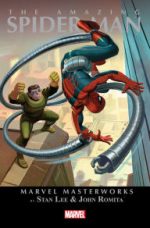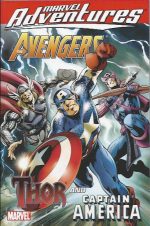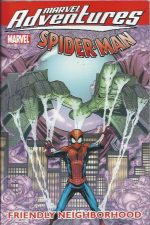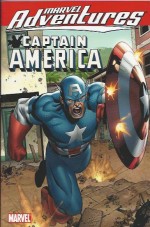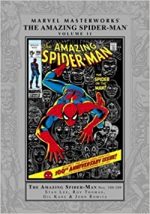
By Stan Lee, Gil Kane, John Romita & various (Marvel)
ISBN: 978-0-7851-3507-4 (HB)
Amazing Spider-Man was always a comicbook that matured with – or perhaps just slightly ahead – of its fan-base. As memories of the Swinging Sixties sank beneath the depressing weight of the Sordid Seventies, that feeling seemed to intensify with every issue…
This electrifying eleventh full-colour collection of chronologically congregated early adventures of the Amazing Arachnoid sees the World’s Most Misunderstood Hero foreshadowing a major change in the tone and timbre of comics even while continuing the long climb to becoming a global household name…
After a rather nervous nativity The Amazing Spider-Man soon became a certified sensation with kids of all ages. Before too long the quirky, charming, thrillingly action-packed comics soap-opera would become the model for an entire generation of younger heroes impatiently elbowing aside the staid, (relatively) old thirty-something mystery-men of previous publications and hallowed tradition.
Smart-but-alienated Peter Parker was bitten by a radioactive spider during a school trip. Discovering strange superhuman abilities which he augmented with his own natural chemistry, physics and engineering genius, the kid did what any lonely, geeky nerd would do with such newfound prowess: he tried to cash in for girls, fame and money.
Making a costume to hide his identity in case he made a fool of himself, Parker became a minor media celebrity – and a criminally self-important one. To his eternal regret, when a thief fled past him one night he didn’t lift a finger to stop him, only to find when he returned home that his guardian uncle Ben Parker had been murdered.
Crazed and vengeful, Peter hunted the assailant who’d made his beloved Aunt May a widow and killed the only father he had ever known, discovering, to his horror, that it was the self-same felon he had neglected to stop. His irresponsibility had resulted in the death of the man who raised him, and the traumatised boy swore to forevermore use his powers to help others…
Since that night, the Wondrous Wallcrawler tirelessly battled miscreants, monsters and madmen, with a fickle, ungrateful public usually baying for his blood even as he perpetually saves them…
Re-presenting Amazing Spider-Man #100-109 – originally released between September 1971 and June 1972 – the astonishing tales begins with ‘The Spider or the Man?’ (by Stan Lee, Gil Kane & Frank Giacoia): a long-anticipated anniversary issue which proved to be a game-changing shocker as, determined to retire and marry, Peter attempts to destroy his powers with an untested self-concocted serum…
The result is a hallucinogenic trip wherein action ace Kane got to draw an all-out battle between Spidey and an army of old enemies, culminating in a waking nightmare when Parker regains consciousness and discovers he’s grown four additional arms…
With #101 Roy Thomas stepped in as scripter for ‘A Monster Called… Morbius!’, as the eight-limbed hero desperately seeks some way to reverse his condition. Fortuitously, he stumbles across a murderous costumed horror who drinks human blood. Making matters even worse is old foe The Lizard who turns up, determined to kill them both…
Amongst the many things banned by the Comics Code in 1954 were horror staples vampires and werewolves, but the changing comics tastes and rising costs of the early 1970s were seeing superhero titles dropping like flies in a blizzard.
With interest in suspense and the supernatural growing, all comics publishers were pushing to re-establish scary comics again, and the covert introduction of a “Living Vampire†in superhero staple Spider-Man led to another challenge to the CCA, the eventually revision of the horror section of the Code and a resurgent rise of supernatural heroes and titles.
For one month Marvel also experimented with double-sized comicbooks (DC’s switch to 52-page issues lasted almost a year – August 1971-June 1972 cover-dates) and Amazing Spider-Man #102 featured an immense, three-chapter blockbuster beginning with ‘Vampire at Large!’ wherein the octo-webspinner and anthropoid reptile join forces to hunt the a science-spawned bloodsucker after discovering a factor in the vampire’s saliva could cure both part-time monsters’ respective conditions.
‘The Way it Began’ briefly diverges from the main narrative to present the tragic secret origin of Nobel Prize winning biologist Michael Morbius and how be turned himself into a haunted night-horror before ‘The Curse and the Cure!’ brings the tale to a blistering conclusion and restores the status quo and requisite appendage-count.
Designed as another extra-length epic, ‘Walk the Savage Land!’ began in the now conventionally paginated #103 but was sliced in half and finished as #104 ‘The Beauty and the Brute’ in #104.
When the Daily Bugle suffers a financial crisis, bellicose publisher J. Jonah Jameson takes Peter Parker and his girlfriend Gwen Stacy on a monster-hunt to the Lost World under the Antarctic, to encounter not only dinosaurs and cavemen but also noble savage Ka-Zar, perfidious villain Kraven the Hunter and terrifying giant alien baby Gog in a fabulous pastiche and homage to Willis O’Brien’s King Kong delivered with love and pride from Thomas, Kane & Giacoia.
Capitalising on an era rife with social unrest and political protest, Stan Lee returned in #105 with ‘The Spider Slayer!’ as the New York City police install spy cameras on every rooftop and discredited technologist Spencer Smythe resurfaces with an even more formidable anti-Spider-Man robot for Jameson to set against the Wall-crawler.
The story also features the release of Harry Osborn from drug rehab and former school bully and gadfly Flash Thompson returning from Vietnam, but the big shock is discovering the once beneficent Smythe has gone totally bonkers…
Responsible for the police spy-eyes too, Smythe observes Spidey without his mask and in ‘Squash! Goes the Spider!’ (triumphantly pencilled by the returning John Romita Sr.) the Professor sells out old employer Jameson, allies with criminal gangs and attempts to plunder the entire city. When the Amazing Arachnid attempts to block the banditry, he finds himself facing the ultimate Spider-Slayer before valiantly battling his way to victory in ‘Spidey Smashes Thru!’
The secret of Flash Thompson starts to unfold in issue #108’s ‘Vengeance from Vietnam!’ (with Romita inking his own pencils) as our troubled war hero reveals an American war atrocity. The event left a peaceful in-country village devastated and a benign wise man comatose and near-dead, consequently setting a vengeful cult upon the saddened soldier’s guilt-ridden heels, which all Spider-Man’s best efforts could not deflect or deter.
The campaign of terror was only concluded in #109 when ‘Enter: Dr. Strange!’ sees America’s Master of the Mystic Arts divine the truth and set things aright, but only after an extraordinary amount of unnecessary violence…
Blending cultural authenticity with captivating art and making a dramatic virtue of the awkwardness, confusion and sense of powerlessness most of the readership experienced daily resulted in an irresistibly intoxicating read, delivered in addictive soap-opera instalments, but none of that would be relevant if the stories weren’t so compellingly entertaining. This is Spider-Man at his very best and also shows the way in which the hero began to finally outgrow his (co)creator.
© 1971, 1972, 2011 Marvel Characters, Inc. All rights reserved.

